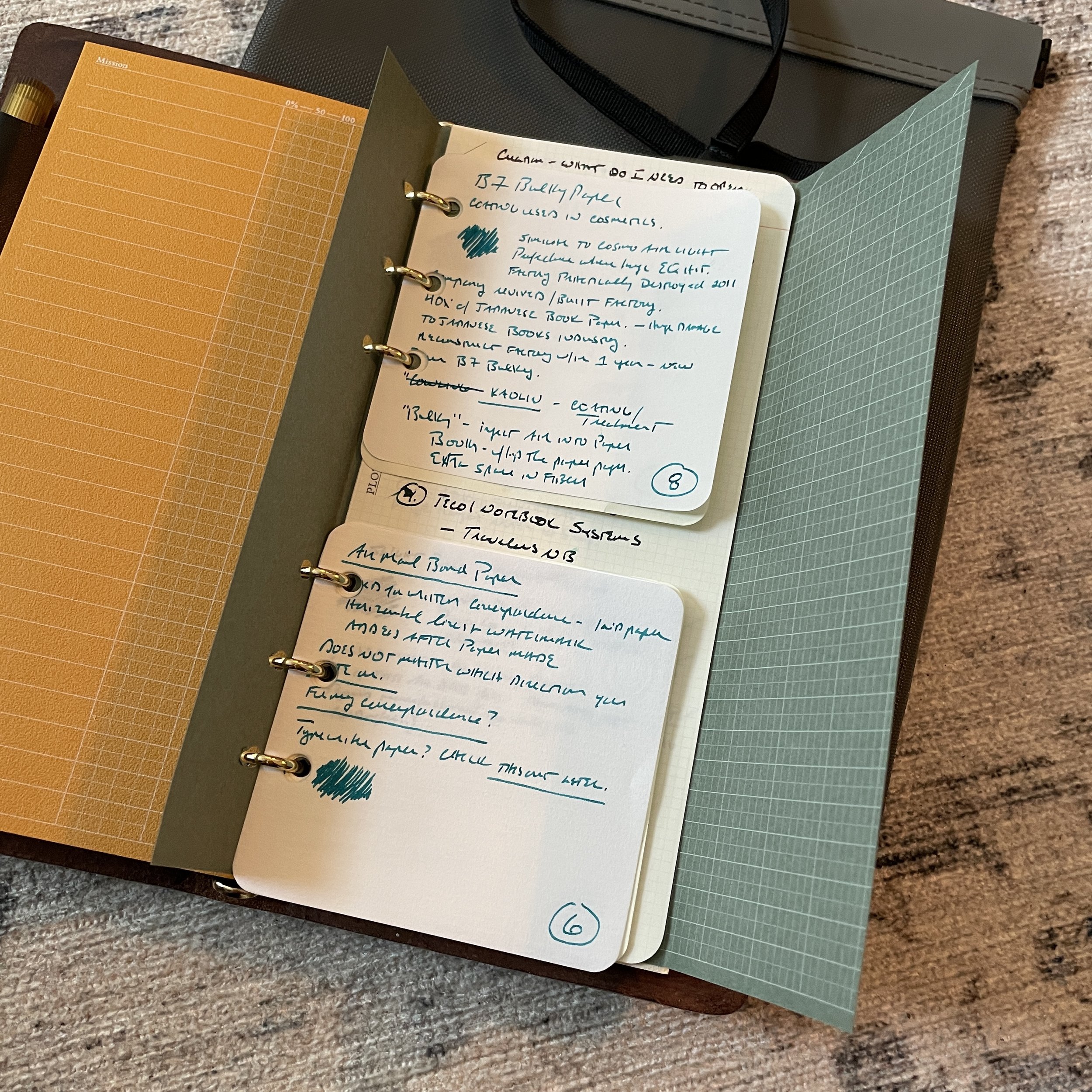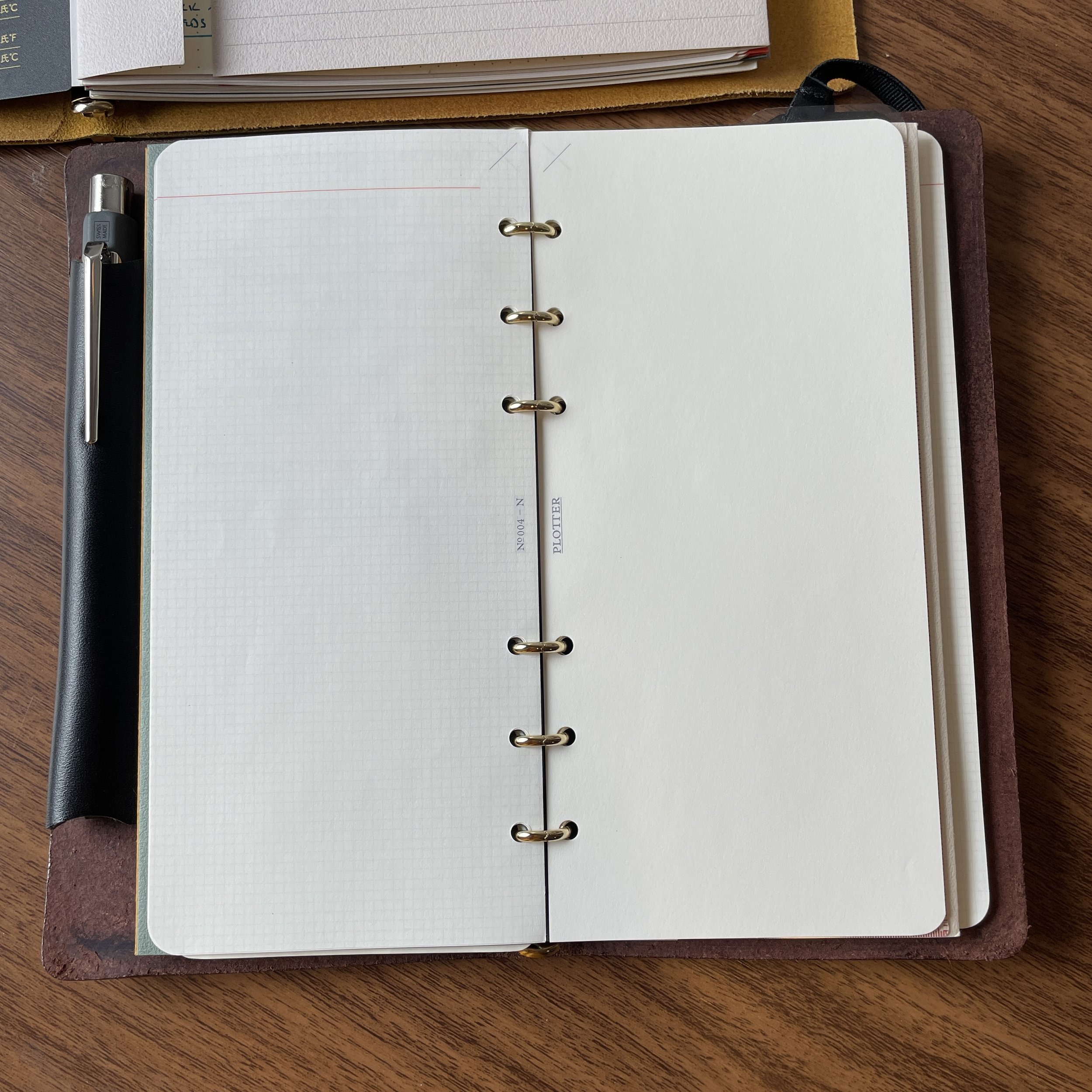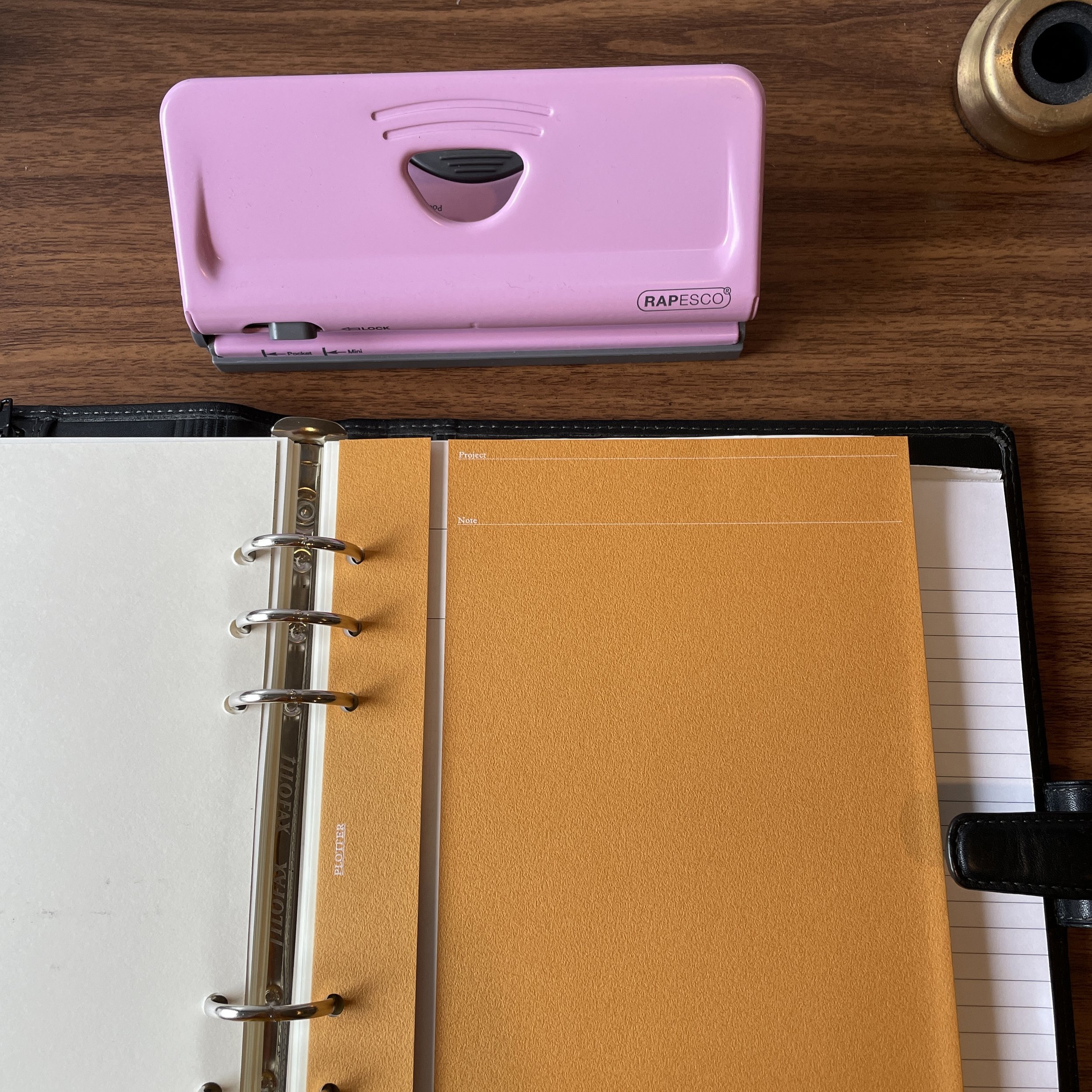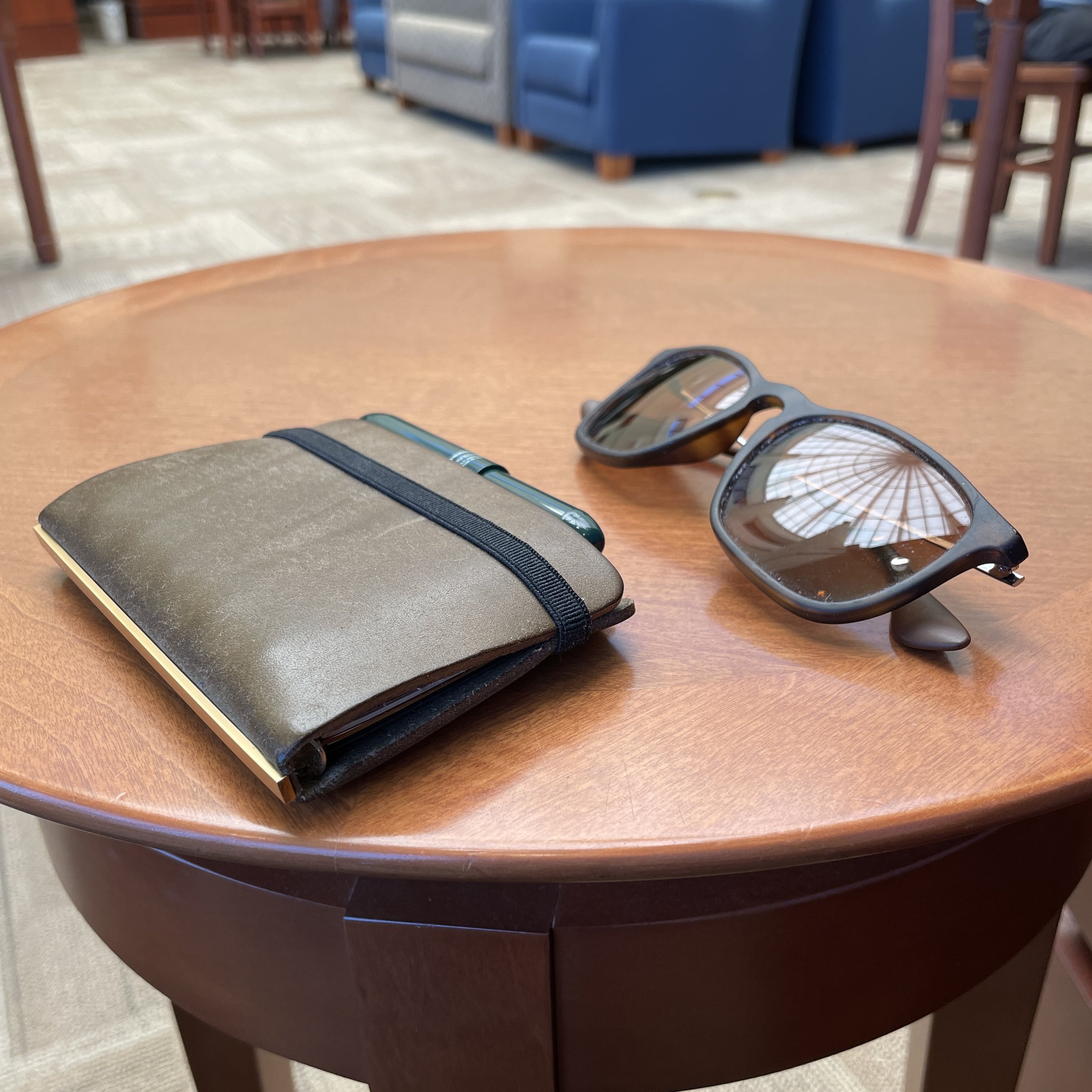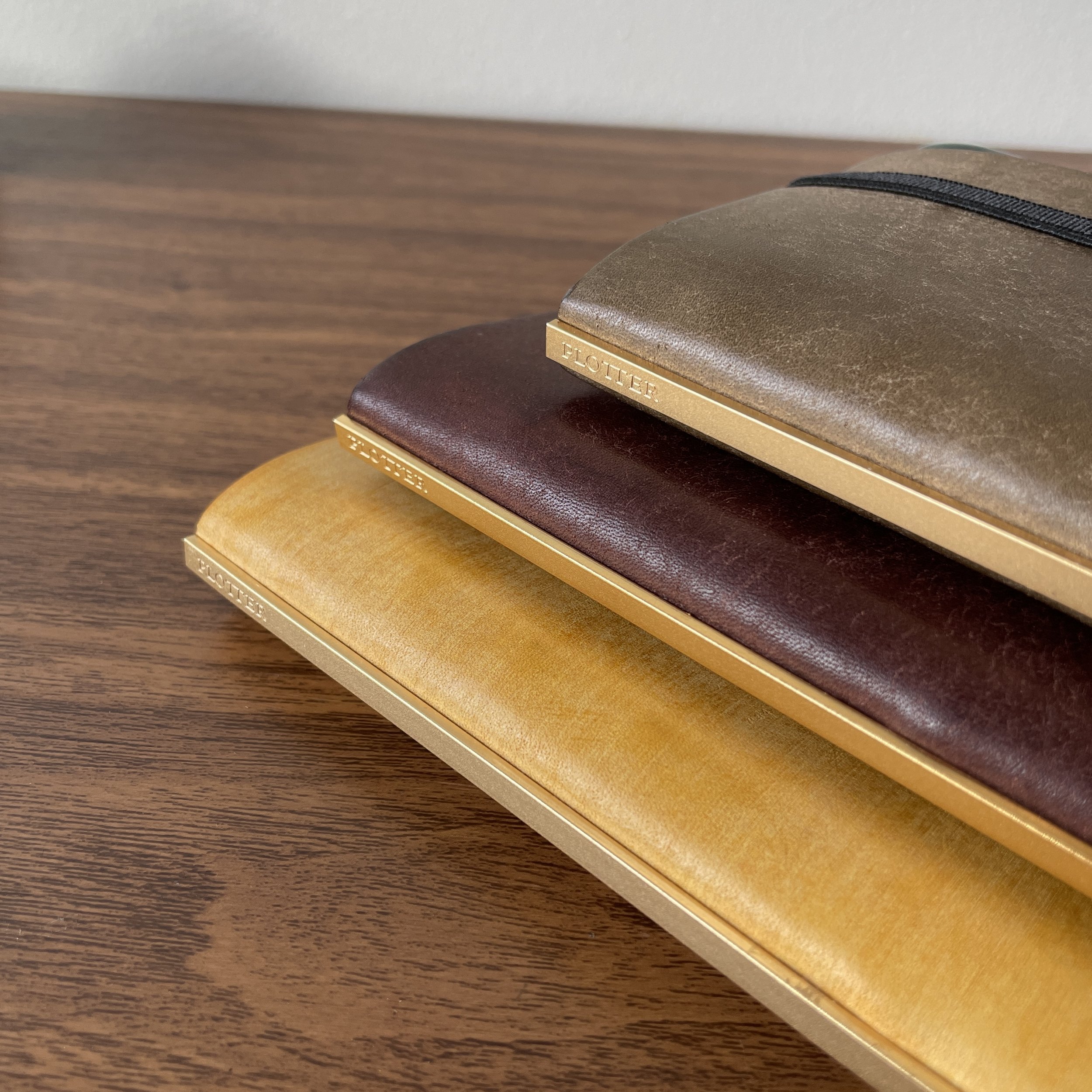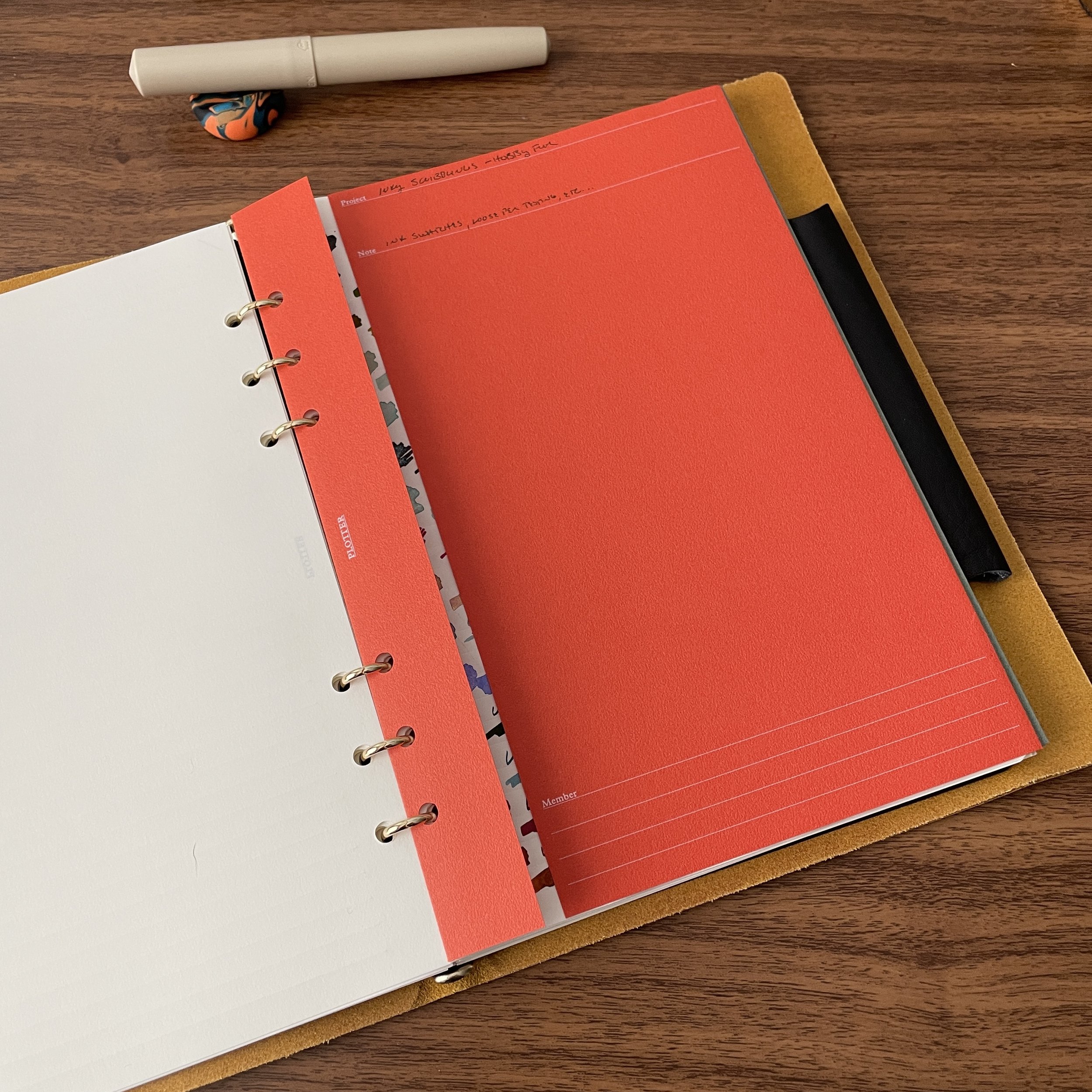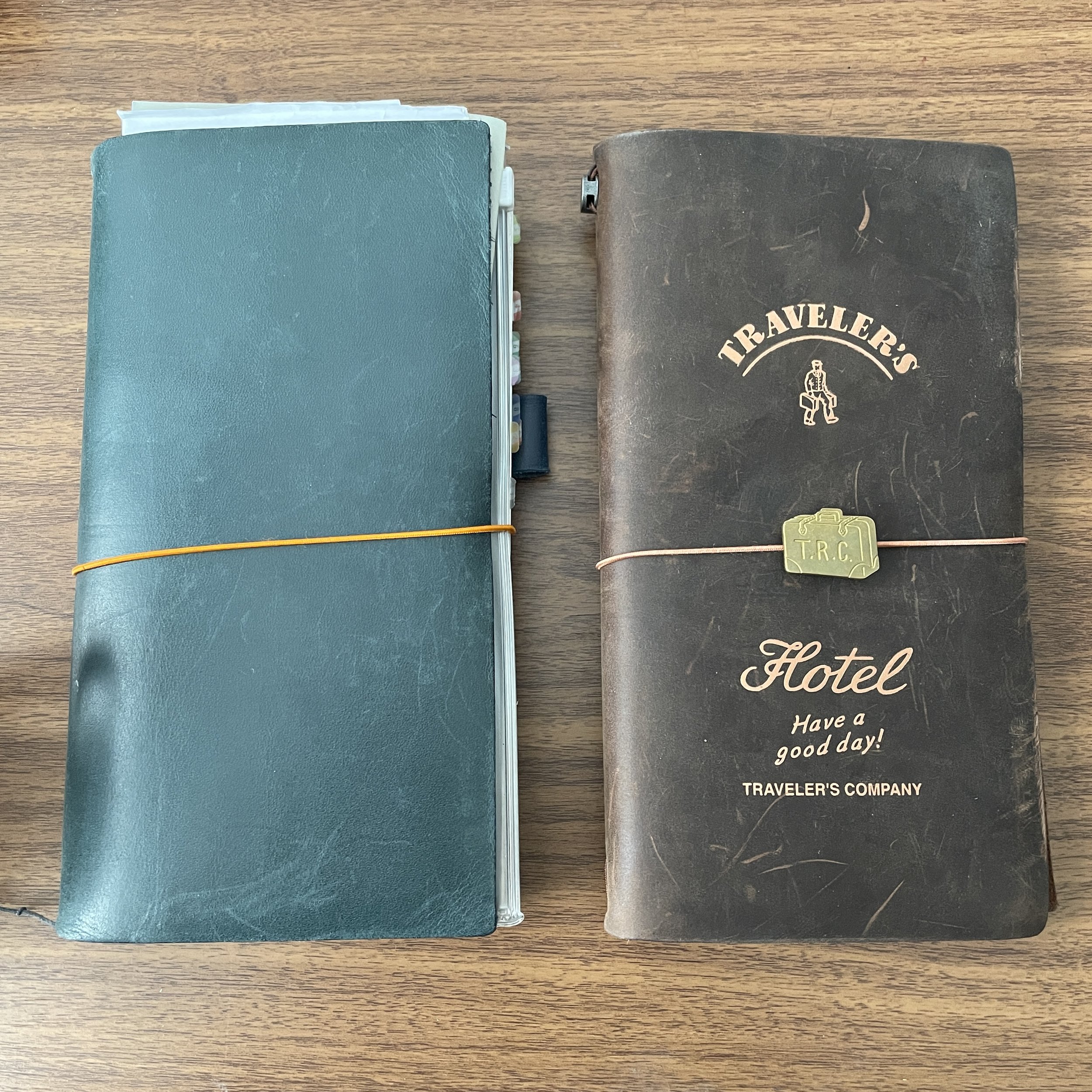Last week’s post, “Guide to Notebook Systems/System Techo, Part I”, offered a brief introduction to different types of notebook systems on the market. One of those categories was the “System Techo,” a Japanese term for a notebook system built around a ringed binder. “System Techo” is not as popular or pervasive in the U.S. as it is in Japan. At one point, Filofax was extremely popular, yet most consider it to be a planner/calendar as opposed to a broader notebook or information management system, and dismiss it as something outdated that they’ll never use. The reality is that ring-based systems can be extremely powerful tools for creativity and organization, especially for those of us who enjoy working on looseleaf paper and notepads but lack a convenient way to organize and archive our ideas. The advantages to a system like this is that you can move around and group together individual pages of notes, as opposed to more modular systems that limit you to bound refills.
With a hole punch, a ring binder can become a powerful tool for collecting and organizing all the ideas many of us collect on random scraps of paper.
What Is Plotter? (Hint: Don’t Write It Off as “Just a Planner System”)
The star of this year’s San Francisco Pen Show was Plotter, a Japanese notebook system that can be used as a planner or organizer, but is actually designed to be something much more open-ended. Since I own three Plotter binders/notebooks, all in different sizes and with different use cases, I plan to walk you through the design of the system, give a brief overview of how it’s intended to be used, and talk a bit about how I’ve been using it in my own life. Whether Plotter is something that could work for you, well, that’s up to you!
Plotter refills and notepads are well designed, and I especially love the bound notepads that can be used as stand-alone notebooks with removable sheets.
The Plotter system is organized around three main components. First, you have the excellent paper, which is DesignPhil’s own proprietary formula, and which I would compare to a slightly thinner version of Midori MD. While certain refills ship in packages of looseleaf sheets, Plotter refills also come bound in pads or notebooks. This convenient design allows you to use the refill as a stand-alone notebook that you can carry with you, tearing out individual sheets to incorporate into your binder as needed. Yes, there is also a diary refill, so you can use your Plotter as a traditional six-ring planner, but that’s not necessarily how the Plotter system was conceived. (More on that below.)
Plotter paper comes in a variety of rulings (dot, lined, grid, and blank), so that you can assemble a notebook with multiple types of paper to use whenever different needs arise.
The second component of the Plotter system is the binder (i.e.,the leather notebook cover). Currently, Plotter users in the U.S. can select from five different sizes: A5, Bible, Narrow, Mini, and Mini 5. The Plotter binder itself is a fairly simple six-ring organizer sold by itself. To build out your Plotter into something that you can personally use everyday, you will use the paper refills and “Accessory Refills” to customize the system. As you can imagine, this is both a blessing and a curse: A blessing because you aren’t necessarily forced into purchasing an overly complex notebook system if all you want is a nice leather binder that holds looseleaf sheets; a curse because if you do want to take advantage of all the (excellent) Plotter components and accessories, you can spend money quickly. For that reason, I would recommend starting simply, purchasing your binder, maybe a set of dividers, and an elastic cord and/or penholder. You can always add more functionality as you go. (Note: Plotter ring spacing is NOT proprietary, so if you have, for example, Filofax refills, dividers, rulers, etc. in the correct size, they should fit your Plotter. Similarly, if you have a Filofax binder and merely want to test out the Plotter accessories and organizational system, everything should fit your existing cover, though no guarantees.)
All Plotter binders feature six rings and a metal bar on the spine. It’s a minimalist design that I find quite attractive.
Finally, the third Plotter component is the “archiving” aspect of the system. Because the Plotter binder is, by design, not necessarily all that capacious, you may need a larger notebook or refill binder to hold spare refills and older notes and other materials that are no longer immediately relevant but that you still want to keep. Plotter does sell a refill binder for archiving, but you can easily use something like a spare six-ring planner with the same ring size. (I have an older Filofax that I’ve been using to hold A5 Plotter sheets and spare refills that don’t currently live in my binder.)
Adding a hole punch (like the inexpensive Rapesco version shown here) will allow you to use paper that you already have on hand. I’m a huge fan of Midori MD Cotton, and I’ve been punching holes in sheets from a standard A5 pad and using it in my Plotter. Also pictured here is the A5 Filofax I use for archiving and refill storage.
How the Plotter System Is Designed to Be Used
To start, there is no “correct” way to use Plotter, or any notebook system or stationery item for that matter. You should incorporate your stationery into your life in a way that works for you, and which will give you maximum utility and enjoyment. That said, there is a specific philosophy informing the design of the system, and when I was at the San Francisco Pen Show last month, I had the opportunity to sit in on a Plotter seminar in which April from DesignPhil (and Penguin’s Creative and Stationery Cafe!) explained the general principles behind Plotter:
Facilitating idea capture and note taking
Refining your notes and ideas, with a focus on identifying the most essential ideas and/or information to keep on you at all time
Providing a flexible, customizable platform that allows you to work creatively in a format that works specifically for you
In other words, the Plotter system was built to make it easy to (1) capture notes and ideas on paper, (2) organize (or at least retain) those ideas in the binder while you develop them, (3) periodically review and revisit your ideas, archiving what you need while disposing of what you don’t. The slim binder design is therefore intentional, encouraging a minimalist approach to notetaking and workflow. This can be a lifesaver for work projects that have a tendency to spiral out of control. How many of you (like me) have notebooks stuffed with months’ or years’ worth of research and meeting notes, of which a dozen or so pages are actually useful to keep long-term?
My three Plotter notebooks: Mini 5 (top); Narrow (center), and A5 (bottom).
How I Use My Three Plotter Notebooks
So who do I think Plotter is for? For someone involved in too many different things (like me) who tends to be kind of scatterbrained (like me) and who works primarily on pads of paper and notepads for the majority of their writing (like me). I’m both an organized and, at the same time, an extremely disorganized person. While I’m generally “organized” in the sense that I do make a regular effort to collect my thoughts related to different projects I’m working on and group them together in some way, I feel disorganized in the sense that I’m seemingly always working on too many things at the same time, often in the same notebook or notepad, and sometimes I’m not sure where the ideas and concepts I’m working on at the time will go, or even whether they ultimately will amount to anything at all. It can feel like I’m carrying around a chaotic mess of paper and it stresses me out. Enter the Plotter as a “creative inbox”, providing just enough structure to keep me sane. I heard someone describe Plotter as “the place to loosely you organize thoughts and ideas until you figure out where they will live long-term,” and that’s an excellent way to describe the system. I have three Plotters:
Plotter A5 (My main “inbox,” containing notes for T.G.S. content and other personal research and writing projects)
Plotter Narrow (Notes, lists, and ideas relating to T.G.S. business operations)
Plotter Mini 5 (I use as a wallet and a pocket notebook/jotter that I carry around at all times)
Each of my Plotters includes a handful of “Project Manager” folders, which allows you to organize sheets by topic. The folders themselves are hole-punched, so if you want to devote a folder to a specific project and move it in and out of your binder as you work on it, you can just pull the entire folder and stick it in your archiving system.
Using my own workflow as an example, I typically think of a half-dozen or so ideas for T.G.S content over the course of any given day. I might sketch out the idea on a sheet of A5 paper, stick it in the “TGS Articles” section of my A5 Plotter (grouped with other similar ideas if applicable), and either build the idea out in the Plotter or transfer it to a dedicated notebook or to the computer if it’s something I actually want to publish or incorporate into one of my longer-form writing projects. Every so often, I’ll review the notes in the Plotter and decide whether they warrant archiving or recycling, if they don’t seem like something I’ll be working on in the near future.
My Plotter Mini 5 goes everywhere with me. This particular notebook is used less for content management than for lists and reference notes that I want to have on me at all times (lists of books to check out from the library, pens I’m looking for at shows, etc.), as well as just a general purpose jotter with removable pages.
Takeaways and Where to Buy
Plotter offers flexibility in a convenient and elegant format, and I personally enjoy using this system more than other ringed organizer systems I have tried. I own three different Plotters, and have been using one of them for well over a year, so for me it has staying power. Over the past month, I’ve seen my Mini 5 notebook in particular become a core piece of my everyday carry, and my A5 Plotter also sees daily use. While Plotter is not an inexpensive system to buy into, as long as I actually continue to use the Plotter regularly over a multi-year period, it will be well worth the money spent. The refills themselves are not actually that expensive, and priced commensurately with other paper products of similar quality, so any expense is mainly associated with the initial setup.
If I had to recommend that new Plotter users purchase one accessory, it would be one of the “lifters” with either a pen loop or an elastic band. The “Lifters” can be placed anywhere in the notebook to serve as either a divider, or as a pencil board or firm surface for writing. For a discussion of which pens fit the Plotter, see this post.
Currently, Plotter can only be purchased through the Plotter USA store, which recently restocked after selling out in the wake of the post-San Francisco Pen Show hype. Binders range anywhere from $96 to $250, depending on the size and the type of leather you select. Looseleaf refills are generally priced in the $6 to $8 range, and Plotter-branded stand-alone notebooks and A4 writing pads are priced at $18. (Tip: you can punch an A4 sheet across the top and fold it in half to include in an A5 binder.) Accessories such as the penholder and elastic “lifters,” project manager dividers, etc. range from $6 to $15, approximately.
Again, the Plotter system is not inexpensive, but these prices are comparable both to other binder systems (like Filofax) and high-end Japanese leather notebook covers such as those from Midori. Moreover, the cost of a $250 notebook setup that you wind up using all-day, every day for years vanishes into the background pretty quickly. That said, anything can - and should - be considered “too expensive” if you never use it.
System Techo can be a powerful tool for those who like to work on multiple projects within a single binder, and value the flexibility to move around individual sheets of paper. In the coming weeks, we’ll be looking at other notebook systems that use different refill options and are built around different philosophies.
Disclaimer: I purchased the A5 and Mini 5 Plotters with my own funds at full price, though I was gifted the Narrow version a year ago as part of Plotter’s U.S. market testing. I was not compensated for this review and this post does not contain any affiliate links.
